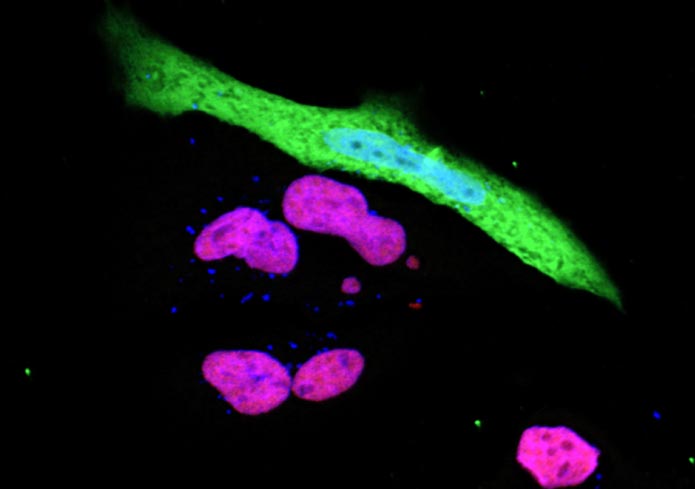Revealed: How SARS-CoV-2 evades our immune system

The expression of the immune response gene NLRC5 (red purple) is suppressed in SARS-CoV-2 (green) infected cells (Photo: Koichi Kobayashi).
Scientists at Hokkaido University and Texas A&M University have identified a key mechanism used by the SARS-CoV-2 virus to evade host immune systems.
Researchers in Japan and the United States have found SARS-CoV-2 can knock out an important molecular pathway linked to an immune complex called MHC class I. The finding should help scientists better understand how COVID-19 infection takes hold.
“Our discovery reveals how the virus can evade the human immune defense system and might help to explain why the pandemic has been so severe,” says Hokkaido University and Texas A&M University immunologist Koichi Kobayashi, who led the study. “The mechanisms we identify may provide new molecular targets for drug discovery.”
The scientists used a bioinformatics approach to look at how SARS-CoV-2, the virus that causes COVID-19, changes gene expression in the immune systems of COVID-19 patients compared to uninfected individuals. This is a useful way to look into the function of complicated cell signalling pathways that trigger immune responses to fight off harmful bacteria and viruses.
MHC (major histocompatibility complex) class I molecules are a central weapon in the immune response against viruses. When a virus infects a cell, the cell facilitates the expression of viral antigens on the surface of infected cells, drawing the attention of immune cells called cytotoxic T cells. These immune cells zero in on and destroy the infected cells, together with the invading virus inside them.
In addition to analysing gene expression in COVID-19 patients, the research team also infected human cell lines with the SARS-CoV-2 virus to validate their findings.
The results showed that a protein from the SARS-CoV-2 virus, called ORF 6, suppresses a host cell protein, called NLRC5, responsible for activating the MHC class I pathway.
The study showed this happens in two ways. ORF6 hampers cell signalling, which turns off the expression of NLRC5. ORF6 also blocks the function of NLRC5.
Other infectious viruses, including HIV and MERS, are known to also target the MHC class I pathway. Researchers believed that SARS-CoV-2 probably did as well, but this study is the first to unravel the mechanism.
“Without the activation of the MHC class I pathway, viruses in the infected cells are essentially hidden from the immune system. That helps to explain why SARS-CoV-2 virus persists in the body and why it keeps infecting others, leading to the pandemic,” Kobayashi says.
Further research could help find and test drugs that block the activity of the ORF6 viral protein, to restore host cell ability to activate the major histocompatibility complex. If successful, such drugs could encourage the host immune system to clear the virus itself, effectively boosting immune responses.
Journal: Nature Communications
DOI: 10.1038/s41467-021-26910-8
Method of Research: Data/statistical analysis
Subject of Research: Not applicable
Article Title: SARS-CoV-2 inhibits induction of the MHC class I pathway by targeting the STAT1-IRF1-NLRC5 axis
Article Publication Date: 15-Nov-2021
COI Statement: The authors declare no competing interests.
Media Contacts
Sohail Keegan Pinto
Hokkaido University
en-press@general.hokudai.ac.jp
Office: +81-11-706-2185
Christina Sumners
Texas A&M University
christina.sumners@tamu.edu
Office: +1-979-436-0616
All latest news from the category: Health and Medicine
This subject area encompasses research and studies in the field of human medicine.
Among the wide-ranging list of topics covered here are anesthesiology, anatomy, surgery, human genetics, hygiene and environmental medicine, internal medicine, neurology, pharmacology, physiology, urology and dental medicine.
Newest articles

Innovative 3D printed scaffolds offer new hope for bone healing
Researchers at the Institute for Bioengineering of Catalonia have developed novel 3D printed PLA-CaP scaffolds that promote blood vessel formation, ensuring better healing and regeneration of bone tissue. Bone is…

The surprising role of gut infection in Alzheimer’s disease
ASU- and Banner Alzheimer’s Institute-led study implicates link between a common virus and the disease, which travels from the gut to the brain and may be a target for antiviral…

Molecular gardening: New enzymes discovered for protein modification pruning
How deubiquitinases USP53 and USP54 cleave long polyubiquitin chains and how the former is linked to liver disease in children. Deubiquitinases (DUBs) are enzymes used by cells to trim protein…



